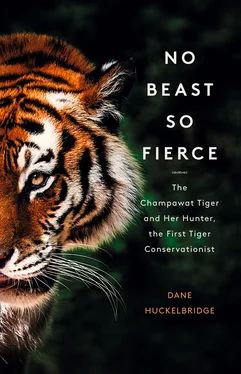Which brings us, inevitably, to colonialism itself—a topic far too broad and multifaceted for any single book, let alone one that’s concerned primarily with man-eating tigers. Yet it is colonialism, undeniably, and the onslaught of environmental destruction that it almost universally heralds, that served as the primary catalyst in the creation of our man-eater. It may have been a poacher’s bullet in Nepal that first turned the Champawat Tiger upon our kind, but it was a full century of disastrous ecological mismanagement in the Indian subcontinent that drove it out of the wild forests and grasslands it should have called home, and allowed it to become the prodigious killer that it was. What becomes clear upon closer historical examination is that the Champawat was not an incident of nature gone awry—it was in fact a man-made disaster. From Valmik Thapar to Jim Corbett himself, any tiger wallah could tell you the various factors that can turn a normal tiger into a man-eater: a disabling wound or infirmity, a loss of prey species, or a degradation of natural habitat. In the case of the Champawat, however, we find not just one but all three of these factors to be irrefutably present. Essentially, by the late nineteenth century, the British in the United Provinces of northern India and their Rana dynasty counterparts in western Nepal had created, through a combination of irresponsible forestry tactics, agricultural policies, and hunting practices, the ideal conditions for an ecological catastrophe. And it was the sort of catastrophe we can still find whiffs of today, be it in the recent spate of shark attacks in Réunion Island, the rise of human–wolf conflict on the outskirts of Yellowstone, or even the man-eating tigers that continue to appear in places like the Sundarbans forest of India or Nepal’s Chitwan National Park. In the modern day, we have at last, thankfully, come to realize the importance of apex predators in maintaining the health of our ecosystems—but we’re still negotiating, somewhat painfully, how best to live alongside them. And that’s to say nothing of the far more sweeping problems posed by global warming and mass extinction, exigencies that have arisen from very much the same amalgamation of economic mismanagement and environmental destruction. Apex predators are generally considered bellwethers of the overall health of the environment, and at present, with carbon emissions on the rise and natural habitats diminishing, the outlook for both feels disarmingly uncertain.
Which is why this particular story of environmental conflict is not only relevant, but urgent and necessary. At its core, Jim Corbett’s quest to rid the valleys of Kumaon of the Champawat Tiger is dramatic and straightforward, but the tensions that underscore it contain the resonance of much larger and more grievous issues. Yes, it is a timeless tale of cunning and courage, but also a lesson, still very much pertinent today, about how deforestation, industrialization, and colonization can upset the fragile balance of cultures and ecosystems alike, creating unseen pressures that, at a certain point, must find their release.
Sometimes even in the form of a man-eating tiger.
PART I
NEPAL
CHAPTER 1
THE FULL MEASURE OF A TIGER
Where does one begin? With a story whose true telling demands centuries, if not millennia, and whose roots and tendrils snake into such far-flung realms as colonial British policies, Indian cosmologies, and the rise and fall of Nepalese dynasties, where is the starting point? Yes, one could commence with the royal decrees that compelled Vasco da Gama to sail for the East Indies, or the palace intrigues that put Jung Bahadur in the highest echelons of Himalayan power. But the matter at hand is something much more primal—elemental, even. Something that’s shaped our psyches and permeated our mythologies since time immemorial, and that speaks directly to the most profound of our fears. To be eaten by a monster . To be hunted, to be consumed, by a creature whose innate predatory gifts are infinitely superior to our own. To be ripped apart and summarily devoured. And with this truth in mind, the answer becomes even simpler. In fact, its golden eyes are staring us right in the face: the tiger . That is where the story begins.
“The normal tiger,” writes Charles McDougal, a naturalist and tiger expert who spent much of his life studying the big cats in Nepal, “exhibits a deep-rooted aversion to man, with whom he avoids contact.” This is a fact corroborated time and time again by biologists, park rangers, and hunters alike, all of whom can attest firsthand to just how shy and elusive wild tigers actually are. One can spend a lifetime in tiger country without ever laying eyes upon an actual tiger, with the occasional pugmark or ungulate skull the only hint at their phantomlike presence. Even for modern-day Tharu who live alongside reserves with dense predator populations, it’s fairly uncommon to see a tiger. Sanjaya, who served as my host and guide in Chitwan while I was conducting research for this book, grew up fishing and foraging in local forests, and in all those years, he had spied a tiger just once. No, the normal tiger has little interest in our kind, and even less in challenging us to a fight. With hunting, mating, and fending off territorial rivals taking up most of its time, the normal tiger has more important things to worry about; we barely rate a passing glance. We are a nuisance to be avoided, and nothing more.
However, for the abnormal tiger—that is to say, the tiger that has shed for whatever reason its deep-seated aversion to all upright apes—there are essentially two ways it will kill a member of our species.
The first category of attack is a defense mechanism, a means of protection, and it is employed only when a tiger sees a human as a threat to its safety or that of its cubs. When a mother tiger is surprised in a forest, or when a wounded tiger is cornered by a hunter, its instincts for self-preservation kick in and the claws come out. This tiger will often roar, come bounding in a series of terrifyingly fast leaps, and commence beating its human target head-on with its front paws, with enough power in most cases to smash the skull after the first strike or two. And from there, it only gets worse—according to Russian tiger specialist Nikolai Baikov, once the offending human is on the forest floor, “the tiger digs its claws as deeply as possible into the head or body, trying to rip off the clothing. It can open up the spine or the chest with a single whack.” This is strictly a combative behavior, the inverse of predation (although defensive attacks do sometimes result in consumption as well). It manifests itself when the tiger senses imminent danger, and for that reason, calls upon its considerable resources to save its own skin—figuratively, and, given the price a tiger pelt can fetch on most black markets, literally as well.
And the results of this behavior, as the rare individual who is both unfortunate enough to encounter it yet still fortunate enough to survive it can tell you, are understandably horrific. There exists a video—and a quick Internet search will readily reveal it—of one such attack that occurred in Kaziranga National Park in northeastern India in 2004. Filmed from atop an elephant, it shows a group of park rangers tracking a problem tiger that had roamed beyond the boundaries of the reserve and begun killing cattle—almost certainly as a result of diminished habitat and limited natural prey. Armed with tranquilizer guns, their intent was not to harm the tiger, but rather to capture it before angry farmers did, and return it safely to its home in the park. But alas, the four-hundred-pound cat was not privy to this plan. Although grainy, and shot with an unsteady hand, the film makes the terrific competence with which a tiger can protect itself abundantly clear. With astounding speed and athleticism, the roaring tiger materializes from the high grass as if out of nowhere, leaps over the elephant’s head with claws at the ready, and with merely a single glancing blow, manages to shred the poor elephant driver’s left hand to bloody ribbons before making its getaway. And this happened to a group of heavily armed men mounted on towering pachyderms—one can imagine what such a tiger could have done to a single individual alone in the forest. They would have been dead before they had time to squeeze off a shot, a fact supported by one lethal Amur tiger attack recorded in 1994 in the Russian Far East—the local hunter’s gun was found still cocked and unfired, right beside his mittens, while his ravaged remains were discovered in a stand of spruce trees one hundred feet away.
Читать дальше












